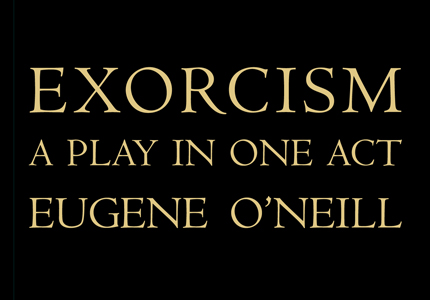World of Letters: Eugene O’Neill’s Yale-Rescued Plays
Eugene O’Neill has oft been regarded as the greatest American playwright. Born in New York City in 1888, O’Neill’s dark and haunted personality, the least of which was a symptom of his depression, made him a notorious creator of fearless drama. Unafraid to confront societal themes that were popularly regarded as taboo or even beneath the taste of drama’s high culture, O’Neill was nothing short of genius, winning his first Pulitzer Prize for Drama for his first published play, Beyond the Horizion, at age 31. Two more Pulitzers followed in the 1920s for his plays, Anna Christie and Strange Interlude, and in 1936 he was awarded the Nobel Prize for Literature.
 Despite a long-standing relationship with Yale—the only institution from which O’Neill accepted an honorary degree after expulsion from Princeton—Yale University Press’s history with the playwright began after his death in 1953. O’Neill had given rights to Long Day’s Journey into Night to publisher and Random House co-founder Bennett Cerf, with the understanding that Cerf would not publish the autobiographical play for at least twenty-five years after O’Neill’s death. O’Neill’s widow and literary executor Carlotta felt differently. Demanding the sealed manuscript stored in Random House’s vault, Carlotta approached Yale University Press and “assured” that Eugene O’Neill had lifted his original restriction on use of the material, now widely considered to be his greatest masterpiece.
Despite a long-standing relationship with Yale—the only institution from which O’Neill accepted an honorary degree after expulsion from Princeton—Yale University Press’s history with the playwright began after his death in 1953. O’Neill had given rights to Long Day’s Journey into Night to publisher and Random House co-founder Bennett Cerf, with the understanding that Cerf would not publish the autobiographical play for at least twenty-five years after O’Neill’s death. O’Neill’s widow and literary executor Carlotta felt differently. Demanding the sealed manuscript stored in Random House’s vault, Carlotta approached Yale University Press and “assured” that Eugene O’Neill had lifted his original restriction on use of the material, now widely considered to be his greatest masterpiece.
 Published in 1956, Long Day’s Journey into Night earned O’Neill a posthumous and unprecedented fourth Pulitzer Prize, and gained the YUP distinction of becoming the fastest selling title in the Press’s then 50-year history. In the decades since, it has remained an organization best seller, with well over half a million copies sold. The Eugene O’Neill archive at Yale’s Beinecke Rare Book and Manuscripts Library has also led to the publication of many other plays and writings from YUP, including The Iceman Cometh, A Moon for the Misbegotten, and letters of his correspondence.
Published in 1956, Long Day’s Journey into Night earned O’Neill a posthumous and unprecedented fourth Pulitzer Prize, and gained the YUP distinction of becoming the fastest selling title in the Press’s then 50-year history. In the decades since, it has remained an organization best seller, with well over half a million copies sold. The Eugene O’Neill archive at Yale’s Beinecke Rare Book and Manuscripts Library has also led to the publication of many other plays and writings from YUP, including The Iceman Cometh, A Moon for the Misbegotten, and letters of his correspondence.
Today, we publish another hidden work by O’Neill: Exorcism: A Play in One Act, which was originally performed in 1920 and disappeared soon after when O’Neill canceled production and ordered all copies of the play destroyed, remarking: “the sooner all memory of it dies the better pleased I’ll be.” But O’Neill’s second wife, Agnes Boulton, whom both he and Carlotta tried to obscure, had retained a copy of the manuscript and later gifted it to screenwriter and producer Philip Yordan. Yordan’s widow then discovered the handwritten manuscript in 2011 among her husband’s papers, complete with handwritten edits by O’Neill himself. The Beinecke acquired the play from a New York bookseller, The New Yorker published the play in its entirety for their October 17, 2011 issue, and finally, the book, complete with a Foreword by Edward Albee, an Introduction by Beinecke curator Louise Bernard, and facsimiles of the original typescript.
 Based on a 1912 suicide attempt by the playwright, Exorcism recreates a defining event that led to O’Neill’s first serious efforts to write. The play displays early examples of his unparalleled skills in capturing deeply personal human drama, and it explores major themes that would permeate his later work. As Bernard writes in the Introduction to the play:
Based on a 1912 suicide attempt by the playwright, Exorcism recreates a defining event that led to O’Neill’s first serious efforts to write. The play displays early examples of his unparalleled skills in capturing deeply personal human drama, and it explores major themes that would permeate his later work. As Bernard writes in the Introduction to the play:
We might read Exorcism in light of what Freud termed the uncanny, here the reemergence or unintentional return of that which is purposefully ‘buried’ or repressed. Just as O’Neill’s suicide bid was abortive, its reenactment introducing a whiff of the Beckettian absurd into his characteristically somber play, so his attempt to destroy, on paper, that which would become a forceful subject in his work, did little to thwart the manuscript’s strange buoyancy, its ability to resurface, out of the blue, after so many decades.




